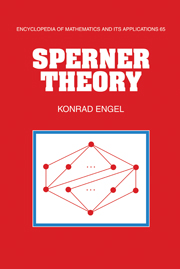Book contents
- Frontmatter
- Contents
- Preface
- 1 Introduction
- 2 Extremal problems for finite sets
- 3 Profile-polytopes for set families
- 4 The flow-theoretic approach in Sperner theory
- 5 Matchings, symmetric chain orders, and the partition lattice
- 6 Algebraic methods in Sperner theory
- 7 Limit theorems and asymptotic estimates
- 8 Macaulay posets
- Notation
- Bibliography
- Index
8 - Macaulay posets
Published online by Cambridge University Press: 08 January 2010
- Frontmatter
- Contents
- Preface
- 1 Introduction
- 2 Extremal problems for finite sets
- 3 Profile-polytopes for set families
- 4 The flow-theoretic approach in Sperner theory
- 5 Matchings, symmetric chain orders, and the partition lattice
- 6 Algebraic methods in Sperner theory
- 7 Limit theorems and asymptotic estimates
- 8 Macaulay posets
- Notation
- Bibliography
- Index
Summary
In this final chapter a theory is presented that is based on the Kruskal–Katona Theorem (Theorem 2.3.6) and its predecessor, the Macaulay Theorem (Corollary 8.1.1). The central objects are the Macaulay posets, and the main theorem says that chain and star products are Macaulay posets. These theorems provide solutions of the shadow-minimization problem, but several other existence and optimization problems can be solved in this theory as well. We restrict ourselves to chain and star products (and their duals) because these have many applications, and both posets are very natural generalizations of the Boolean lattice. Recall that we already know much about these special posets S(k1,…,kn) and T(k1,…,kn). We proved that they are normal and have log-concave Whitney numbers; see Example 4.6.1. In particular, they have the strong Sperner property. Furthermore, chain products are symmetric chain orders; see Example 5.1.1 (and, moreover, ssc-orders; see Example 5.3.1), and are unitary Peck; see Example 6.2.1.
A more detailed study of isoperimetric problems, also in other structures, such as toroidal grids, de Bruijn graphs, and so forth, will be presented in the forthcoming book of Harper and Chavez [261]. We refer also to Bezrukov [57, 58] and Ahlswede, Cai, Danh, Daykin, Khachatrian, and Thu [6]. In the case of chain products, we will further investigate two types of intersecting (resp. cointersecting) Sperner families and discuss some other properties. A complete table for several classes of families, as it was given in Chapter 3 for the Boolean lattice Bn, is not known and seems to be difficult to find since Katona's circle method does not work here. However, in some cases the succeeding theory may replace the circle method.
- Type
- Chapter
- Information
- Sperner Theory , pp. 332 - 389Publisher: Cambridge University PressPrint publication year: 1997

